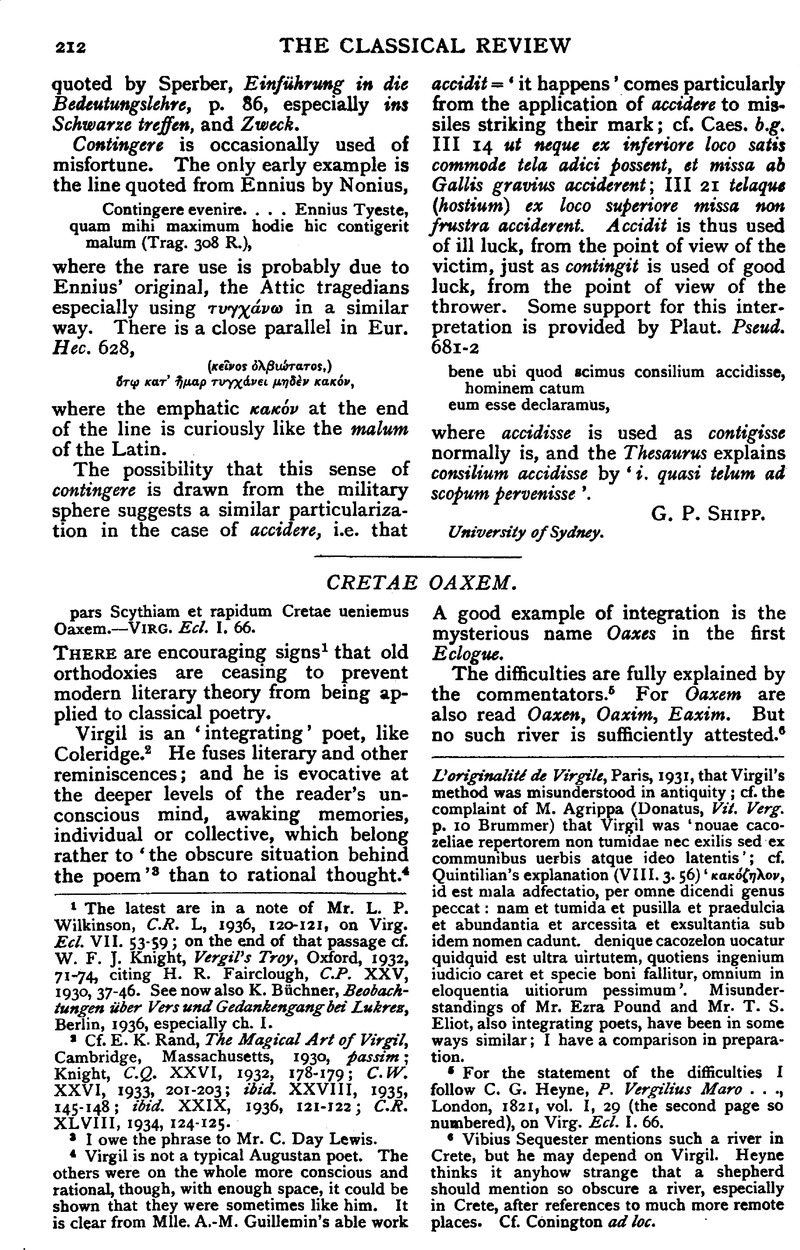No CrossRef data available.
Article contents
Cretae Oaxem
Published online by Cambridge University Press: 27 October 2009
Abstract

- Type
- Review Article
- Information
- Copyright
- Copyright © The Classical Association 1937
References
page 212 note 1 The latest are in a note of MrWilkinson, L. P., C.R. 50, 1936, 120–121Google Scholar, on Virg. Eel. VII. 53–59; on the end of that passage cf. Knight, W. F. J., Vergil's Troy, Oxford, 1932, 71–74Google Scholar, citing Fairclough, H. R., C.P. 25, 1930, 37–46.Google ScholarSee now also Büchner, K., Beobachtungen über Vers und Gedankengangbei Lukres, Berlin, 1936, especially ch. I.Google Scholar
page 212 note 2 Cf. Rand, E. K., The Magical Art of Virgil, Cambridge, Massachusetts, 1930, passim;Google ScholarKnight, C.Q. 26, 1932, 178–179;Google ScholarC.W. 26, 1933, 201–203;Google Scholaribid. XXVIII, 1935, 145–148; ibid. XXIX, 1936, 121–122; C.R. 68, 1934, 124–125.Google Scholar
page 212 note 3 I owe the phrase to Mr. C. Day Lewis.
page 212 note 4 Virgil is not a typical Augustan poet. The others were on the whole more conscious and rational, though, with enough space, it could be shown that they were sometimes like him. It is clear from Mile. Guillemin's, A.-M. able work Ľoriginalité de Virgile, Paris, 1931, that Virgil's method was misunderstood in antiquity; cf. the complaint of M. Agrippa (Donatus, Vit. Verg. p. 10 Brummer) that Virgil was ‘nouae cacozeliae repertorem non tumidae nee exilis sed ex commumbus uerbis atque ideo latentis’; cf. Quintilian's explanation (VIII. 3. 56) ‘κακóζηλον id est mala adfectatio, per omne dicendi genus peccat: nam et tumida et pusilla et praedulcia et abundantia et arcessita et exsultantia sub idem nomen cadunt. denique cacozelon uocatur quidquid est ultra uirtutem, quotiens ingenium iudicio caret et specie boni fallitur, omnium in eloquentia uitiorum pessimum’. Misunderstandings of Mr. Ezra Pound and Mr. T. S. Eliot, also integrating poets, have been in some ways similar; I have a comparison in preparation.Google Scholar
page 212 note 5 For the statement of the difficulties I follow Heyne, C. G., P. Vergilius Maro…, London, 1821, vol. 1, 29 (the second page so numbered), on Virg. Eel. I. 66.Google Scholar
page 212 note 6 Vibius Sequester mentions such a river in Crete, but he may depend on Virgil. Heyne thinks it anyhow strange that a shepherd should mention so obscure a river, especially in Crete, after references to much more remote places. Cf. Conington ad loc.
page 213 note 1 It is thought to be the Axos of Hdt. IV. 154.
page 213 note 2 Apoll. Rhod. I. 1131.
page 213 note 3 Heyne cites Q. Curt. VII. 10, who says that a river Oxus carried down mud; but he thinks the construction of rapidum with cretae harsh. He tends to favour the ancient emendation Araxem, citing Claud. B. Gild. 31, where MSS. fluctuate between Oaxem and Araxem, and Theocr. XVI. 99–100, where the mention of Scythia and Babylonia as typically distant places would have affected Virgil. Heyne decides that Virgil should be forgiven, though he will not defend him; that Virgil may have been using a lost poem; and that his error shows from what an unpromising start he developed his mature poetry. Heyne quaintly ends by asking how the shepherds could have reached Britain or Crete with their flocks.
page 213 note 4 Such fusions in the minds of writers are not unlike the confusions of copyists; cf. Friedrich, Wolf-Hartmuth, Untersuchungen &u Senecas dramatischer Technik, Borna - Leipzig, 1933, passimGoogle Scholar, and Empson, W., Seven Types of Ambiguity, London, 1930, 102–109. ‘Sermons in books…’.Google Scholar
page 213 note 5 Cf. Roiron, F.-X. M. J., Étude sur ľImagination auditive de Virgile, Paris, 1908, passim;Google ScholarGelder, J. van, De Woordherhaling bij Catullus, The Hague, 1934, passim.Google Scholar
page 213 note 6 A reason for supposing that cretae is nearer to Virgil's real thought is the observation made by Heyne and Conington that Crete is too near and familiar to be joined with remote, little known, lands. When Virgil first chose to add ‘Oaxes’, he probably considered it an Asiatic river, without clearly thinking of Crete. But it is doubtful whether poetic ‘ambiguities’ can be judged like this; though even in Virgil, according to the late Professor R. S. Conway, one meaning generally predominates over the others. The construction of rapidum cretae is quite satisfactory; Virgil elsewhere uses rapidus ‘etymologically’.
page 213 note 7 Cf. supr., the first three notes.
page 213 note 8 Lowes, John Livingston, The Road to Xanadu2, London, 1933, passim, and especially 373–376;Google Scholar Rand (as cited in note 2 above) shows that Virgil's method is like the method of Coleridge as discovered by Lowes. Cf. my review of Rand, C. W. 28, 145–148.Google Scholar
page 213 note 9 A ‘portmanteau’ name, accepted by a poet, becomes in a sense real to him, and can be used with other names, belonging to real people and places. Kubla Khan himself is historical; but Xanadu and Abora are fanciful. The parallel meets the objection that a poet would not combine real names with a ‘portmanteau’ name.


